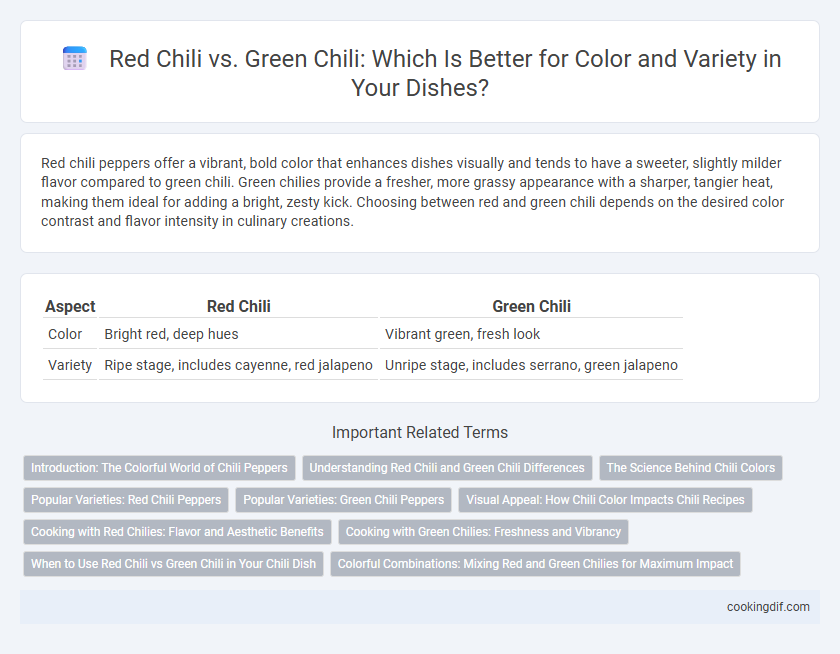Red chili peppers offer a vibrant, bold color that enhances dishes visually and tends to have a sweeter, slightly milder flavor compared to green chili. Green chilies provide a fresher, more grassy appearance with a sharper, tangier heat, making them ideal for adding a bright, zesty kick. Choosing between red and green chili depends on the desired color contrast and flavor intensity in culinary creations.
Table of Comparison
| Aspect | Red Chili | Green Chili |
|---|---|---|
| Color | Bright red, deep hues | Vibrant green, fresh look |
| Variety | Ripe stage, includes cayenne, red jalapeno | Unripe stage, includes serrano, green jalapeno |
Introduction: The Colorful World of Chili Peppers
Red chili peppers develop their vibrant color as they ripen, offering a sweeter, more complex flavor compared to the sharper, grassy taste of green chili peppers harvested earlier. Varieties like cayenne and Thai red chili are prized for their bold, intense heat and deep red hue, while green chili varieties such as jalapenos and serranos provide fresher, milder spice with a bright green color. The color differentiation not only signals ripeness but also influences culinary uses, nutritional content, and capsaicin levels in these versatile peppers.
Understanding Red Chili and Green Chili Differences
Red chili and green chili differ primarily in maturity and flavor profile, with red chilies being fully ripened and offering a sweeter, more complex taste while green chilies are harvested earlier and provide a fresh, sharp heat. Varieties such as cayenne, jalapeno, and serrano can be found in both colors, reflecting the stage of ripeness rather than distinct species. The color difference also influences culinary use, with red chilies often used for dried powder and sauces, whereas green chilies are preferred fresh in salsas and garnishes.
The Science Behind Chili Colors
Red chili peppers gain their vibrant color through the increased presence of carotenoids, primarily capsanthin and capsorubin, which develop as the fruit ripens. Green chilies contain higher levels of chlorophyll, which masks these pigments until the pepper transitions from unripe to ripe stages. The variation in chili color is a direct result of pigment composition changes tied to maturation and genetic factors within different Capsicum species.
Popular Varieties: Red Chili Peppers
Red chili peppers, known for their vibrant red color and intense heat, include popular varieties such as Cayenne, Kashmiri, and Byadgi. Red chilies are ripe fruits that have been left to mature longer than green chilies, resulting in deeper flavor profiles and richer color. These varieties are frequently used in dried or powdered form to enhance the color and spiciness of dishes in global cuisines.
Popular Varieties: Green Chili Peppers
Green chili peppers, such as Serrano, Jalapeno, and Anaheim, are valued for their fresh, vibrant color and milder heat compared to red chili peppers like cayenne or bird's eye. The green varieties are harvested earlier, retaining a bright green hue that adds a refreshing taste and crisp texture to dishes. Popular in many cuisines, green chilies enhance flavor without overpowering heat, making them versatile in salsas, stir-fries, and sauces.
Visual Appeal: How Chili Color Impacts Chili Recipes
Red chili peppers bring vibrant color and intense heat to dishes, enhancing visual appeal with their rich, warm hues that signal maturity and sweetness. Green chilies offer a fresher, sharper taste with a bright, crisp appearance, adding a lively contrast to recipes. The choice between red and green chilies influences not only flavor complexity but also the overall presentation, making color a key factor in culinary design.
Cooking with Red Chilies: Flavor and Aesthetic Benefits
Red chilies offer a rich, vibrant hue that enhances the visual appeal of dishes, making them a popular choice for both presentation and flavor. Their fully ripened state provides a sweeter, more complex heat compared to green chilies, which are sharper and more grassy in taste. Cooking with red chilies adds depth and warmth to sauces, stews, and marinades, while also contributing antioxidants and vitamins that support nutritional value.
Cooking with Green Chilies: Freshness and Vibrancy
Green chilies offer a vibrant, fresh color that brightens dishes and provides a sharper, more herbaceous flavor compared to the deeper, sweeter tones of red chilies. Varieties such as jalapeno and serrano are popular green chilies prized for their crisp texture and moderate heat, making them ideal for salsas, salads, and garnishes. Cooking with green chilies enhances the visual appeal and adds a lively, zesty flavor profile that complements fresh ingredients and balances richer, spicier components in recipes.
When to Use Red Chili vs Green Chili in Your Chili Dish
Red chili peppers, known for their vibrant hue and sweeter, more complex flavor, are ideal for adding depth and rich color to slow-cooked chili dishes and stews. Green chilies offer a fresher, more herbaceous taste with higher heat levels, making them perfect for salsas, fresh toppings, and recipes requiring a bright, piquant kick. Selecting red versus green chili depends on the desired flavor intensity and visual appeal, with red chilies enhancing warmth and richness while green chilies bring sharpness and vibrancy to your chili dish.
Colorful Combinations: Mixing Red and Green Chilies for Maximum Impact
Red chili peppers offer vibrant, warm hues while green chilies bring fresh, crisp tones, creating a visually striking contrast when combined. Their differing spice levels and flavor profiles enhance dishes by balancing heat and freshness, making colorful combinations appealing both aesthetically and gastronomically. Using a blend of red and green chilies elevates the visual impact and depth of flavor in culinary creations, highlighting variety in texture and spice.
Red chili vs green chili for color and variety Infographic

 cookingdif.com
cookingdif.com